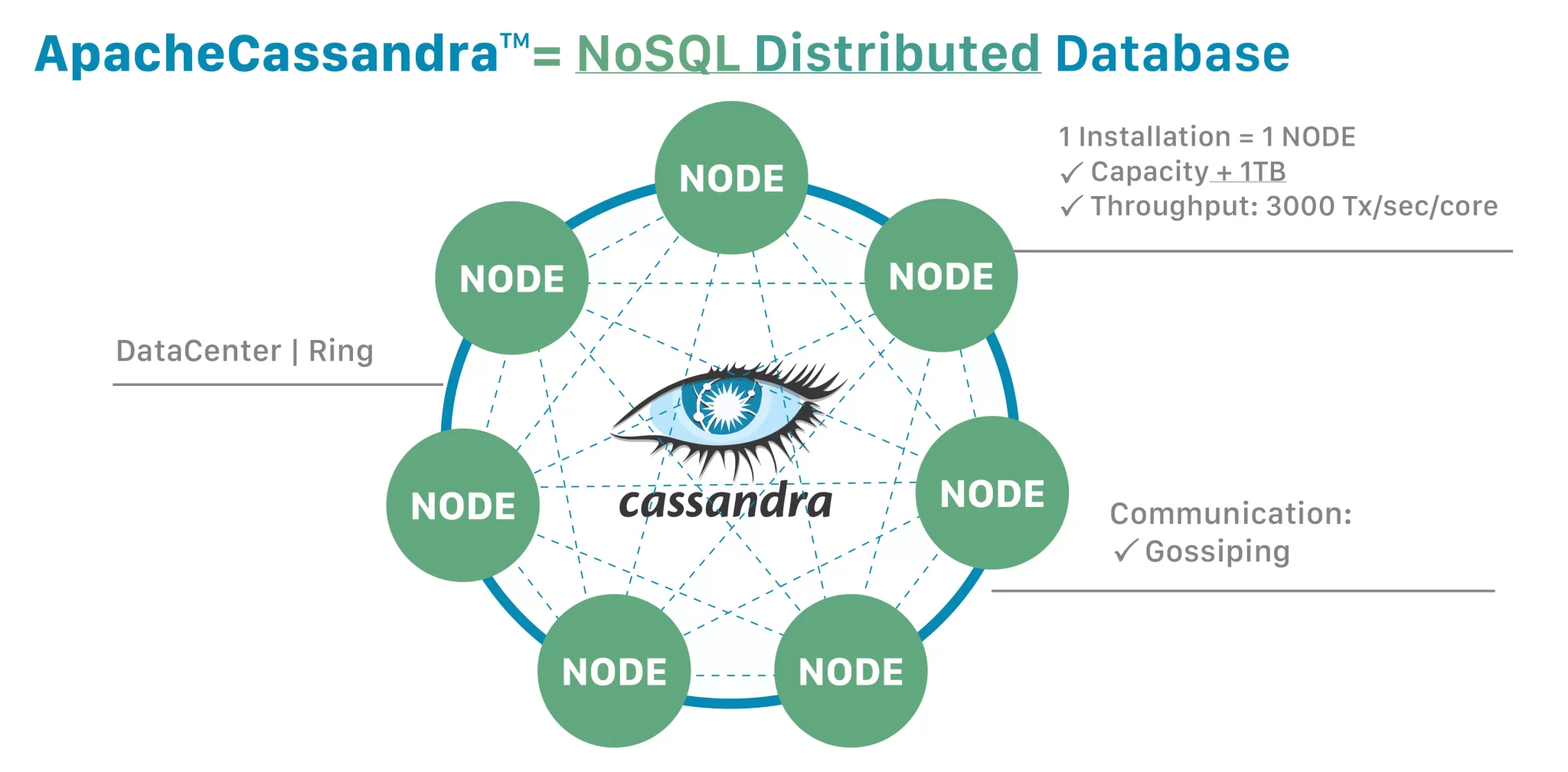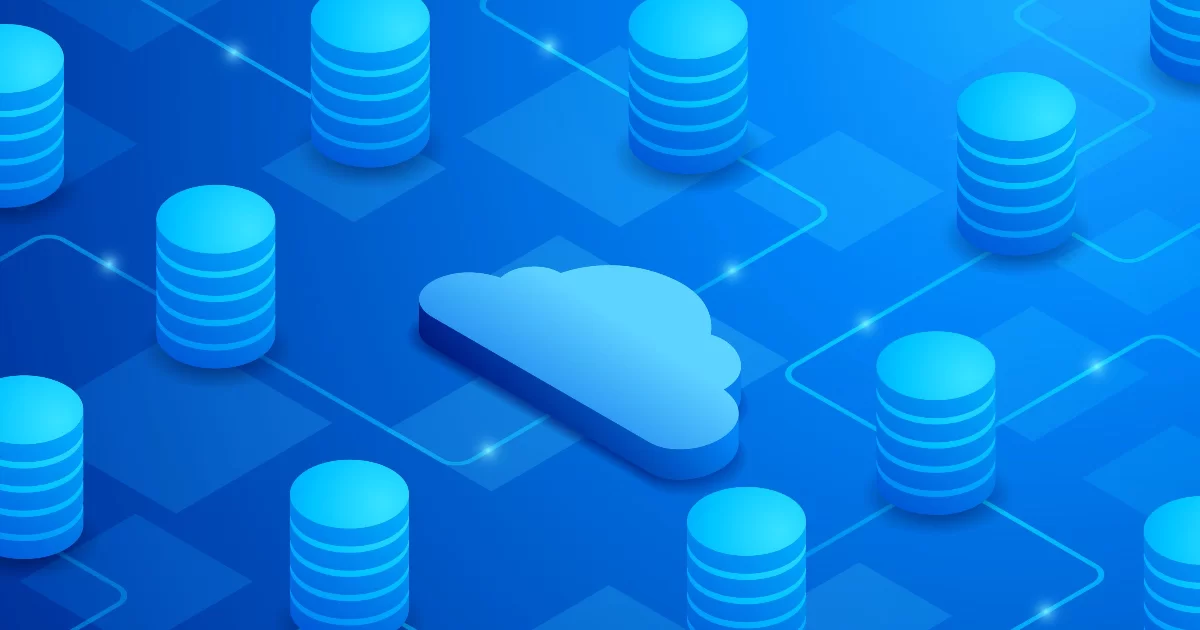What is the Apache Cassandra database and what are its uses?
What is Apache Cassandra Database? You can read this article if you want a complete answer. The Apache Cassandra database is a type of NoSQL database that is open-sourced to software developers and has many features that distinguish it from other competitors. The data storage model in this database is distributed, providing high recall speed, reliability, and availability.
Why is the Apache Cassandra database so popular?
Apache Cassandra is one of the best options if you want to learn a NoSQL language in your various software projects. A large community of developers supports this database, and famous companies use it in their projects.

Cassandra is one of the light and lightweight databases and has shown distinctive features in managing massive data. In recent years, the need for extensive data management and access to rapid scalability in cloud systems has led to the popularity of NoSQL databases such as Cassandra, which have overcome the limitations of other databases in this area.
History of the Apache Cassandra database
Cassandra was created to give web development professionals access to a reliable, distributed database that has high capacity and can be easily scaled up or down. The initial idea of this database was created in 2009 and was used in the early stages of Facebook.
At that time, a robust and reliable database was needed to exchange data at high speed and also manage the increase of users of this platform. Although this database worked well for Facebook, the company decided to replace Cassandra with HBase, another type of NoSQL database. However, Cassandra is still used on Instagram, a subset of Meta with over a billion monthly active users.
Cassandra’s popularity remained unchanged after 2009 and increased in subsequent time frames. Except for Meta, other big companies such as Amazon, Reddit, Twitter, and Cisco also use this database in their different departments. According to statistics, until 2012, this database has been deployed thousands of times in small and large global companies, one of the most famous of which is eBay.
What is a NoSQL database?
NoSQL database or Not Only SQL is a feature in which the database can store and retrieve data without needing a tabular format. Unlike relational databases with tabular form, NoSQLs such as Apache Cassandra allow access to unstructured data, which has the following benefits.
- Simple and uncomplicated design
- Horizontal scaling
- Excellent control over data access
NoSQL databases have found great use in big data and real-time web applications today because they are easy to use; the concurrent performance of these databases has proven itself in large-scale processing.
Replication: The ability to make copies of data is provided in NoSQL databases, where copies of information are stored and maintained on different servers. This is the reason that data recall is more reliable, and with its use, stored data and information can be accessed at other times. Of course, this will require additional storage space and increase costs somewhat. However, for many businesses worldwide, downtime costs much more than allocating extra storage space for data. In practice, these types of companies prefer to increase the cost of servers to avoid losses due to outages.
Among the most essential and popular NoSQL databases, the following can be mentioned, which are used by small and large companies in the world:
- Apache Cassandra
- Apache HBase
- MongoDB
How does the Apache Cassandra database work?
How does the Apache Cassandra database work? A question that understanding will help a lot to be able to configure and use this database in a better way. The Apache Cassandra database is based on a point-to-point or peer-to-peer system, whose basic structure is a cluster of nodes.

Note that each of these nodes can send read and write requests, and this is one of the essential features of the Apache Cassandra database that distinguishes it from others. This database has no controller node, meaning all nodes work the same way. The related nodes in the data centers are collected in a group. In the case of needing more capacity and memory, this capability can be achieved by adding more nodes.
In the Apache Cassandra database, data is stored and retrieved using a partitioning system. The system will determine the data with which code and where it will be held.
Need more power? Increase the nodes!
You may have worked with databases such as Oracle or MySQL. In this type of database, the development and increase of power are based on the rise in processing power, the amount of RAM, and the,e use of faster storage disks. Focusing on each of these items directly correlates with increasing costs, which may result in many additional costs for a large company.
The Apache Cassandra database makes it possible to effortlessly increase the power of the database whenever needed, without interruption, by using node expansion. To double the capacity or throughput, the number of nodes in this database can be folded, and this possibility is provided without interrupting access.
Besides this, if you need to restore the previous state and reduce the capacity, this is also easily possible. The Apache Cassandra database has eased your mind in this regard.
What are the applications of the Apache Cassandra database?
What are the applications of the Apache Cassandra database? This is one of the questions that will surely come to your mind after familiarizing yourself with this database. Why should we learn Apache Cassandra, and what features have increased its use in recent years?
This feature has specific features that we will explain in the following, but in this section, it is better to know a little about using the Apache Cassandra database.
Apache Cassandra is used by many large technology companies and reputable companies working in the following industries:
Application of Apache Cassandra database in online business
Online business is a profitable and vital industry in which data exchange is critical. For a safe and secure sale, it is necessary to store data, company information, and information correctly related to customers to use these data when access is needed. One of the critical points in online business for store websites is the existence of many users and customers who may visit the website and store in a certain period.
In this situation, the users will surely suffer from the interruption of the online platform, and any problem may result in the loss of the company’s customers. Online businesses can avoid these problems by deploying reliable capabilities like Apache Cassandra. Due to proper fault tolerance, Apache Cassandra can continue to work even during high-traffic times.
Suppose an online business platform needs to increase capacity and improve performance. In that case, Apache Cassandra has the best advantages, and you can manage the situation with good scalability.
Application of Apache Cassandra database in entertainment websites
One of the best uses of the Apache Cassandra database is for entertainment websites, including movie websites, online games, and music streaming websites. Due to this database’s critical capabilities to the developer, it is possible to reliably record accurate data and information related to users. These data will be analyzed in the next step and can be used to improve the user experience and increase the quality of website services.
It is interesting to know that one of the biggest developers of this database is Netflix, which is known as an entertainment service. One of the most important goals of developing this database has been to help improve the user experience by reducing outages and such problems.
Application of Apache Cassandra database in the Internet of Things
The Apache Cassandra database is also widely used in the Internet of Things industry, and due to the increasing popularity of IoT, the use of this database can be seen to increase. The vast data generated through IoT tools and devices must be stored and processed optimally and reliably; in the meantime, Apache Cassandra is one of the best options.
Many devices may be connected to an IoT network, and from sensors and wearables to central devices, they all generate data that ultimately needs to be managed.
This database can manage a large amount of information, and its essential advantage is the possibility of instant analysis. For this reason, the IoT industry is one of the largest sectors to deploy Apache Cassandra.
Application of Apache Cassandra database in the logistics and transportation industry
In the transportation and logistics sector, it is necessary to control the conditions of delivery of goods and consignments simultaneously. For the optimal management of this work, a safe and secure database is needed. From the first step, the purchase of an item, until the item is delivered to the customer or retailer, you can use applications that connect to the Apache Cassandra database and provide secure read and write capabilities.
Due to the excellent capabilities of this database, it can be used for large logistics companies, which may have a lot of data compared to smaller companies. In recent years, Apache Cassandra has shown more advantages than many databases in the back-end web sector.
Application of Apache Cassandra database in fraud prevention and authentication
Authentication and fraud prevention is one of the most critical parts of data security faced by small and large companies. Access to a secure and reliable database for this work becomes more acute, especially for banks and financial companies, and any problem in data analysis and storing and reading information may lead to irreparable losses.
Cassandra also has much to say in this industry, and financial companies and banks have used this database as a security feature in recent years. This increased use is due to the possibility of instant analysis and the ability to process a large amount of data quickly. In other words, such companies must establish an integrated authentication system that can analyze and respond quickly and instantly. These capabilities are all present in Cassandra, and the continuous responsiveness of this database is one of the advantages that doubles its value.
What is the Apache Cassandra database ecosystem?
Because Cassandra is currently one of the world’s most popular and influential databases, a large community of developers and software companies are working to help develop it and integrate it into projects. Some of these efforts are on integrating this database with big data projects, and in the meantime, the action is to use this database optimally with Apache Kafka.

Also, Cassandra can be used alongside Apache Spark and Hadoop to achieve extensive data analysis capabilities. This database’s data visualization conditions are also available, and database developers and administrators can use visualization tools to display and analyze data. All these improvements are because this database is free, encouraging developers to use its exclusive features. Currently, Cassandra can be used with the following programming languages:
- C++
- C#/.NET
- DART
- GO
- JAVA
- NodeJS
- PHP
- Python
- Ruby
- Etc.
What are the advantages of the Apache Cassandra database?
Cassandra database has many advantages; we will explain 6 of them below. It is better to know that one of the essential features of this database is its Open Source and its high scalability, which has made it easy for developers to use.
- Free Features: Nothing appeals to developers like a software package being free. Cassandra has been made available to database administrators as an open source, significantly contributing to its popularity and increased use over the years. It is possible to install and configure this database in a few minutes, and then you will be able to use the free features of this database.
- Distributed Points: The Apache Cassandra database considers Headless and distributed architecture, where each node will act independently. In this method, even if there is a complete disconnection with the data center, the data is accessible. Every node in the cluster has the same role, and no single point of failure exists. This way, user data is distributed across the group, and nodes can serve requests.
- Excellent scalability: The high scalability of the Apache Cassandra database has made it possible to increase or decrease the capacity when needed without much difficulty. The excellent scalability of this database is due to its nodal architecture, which can ultimately increase the required power. Increasing capacity in the Apache Cassandra database is accessible and not limited to location. Adding or removing nodes will make adjusting the database according to needs easy.
- High fault tolerance: This database has a high fault tolerance because Apache Cassandra allows information to be stored in different locations and on other nodes. With these conditions, when a node or data center encounters a problem, the entire system will not shut down, and information can be used. Data Replication is a feature of the Apache Cassandra database that will ultimately lead to a unique backup and recovery situation.
- Point-to-point architecture: Apache Cassandra uses a point-to-point architecture for all nodes, where all nodes are considered the same. Unlike many databases with a slave-master structure, where problems may arise, Apache Cassandra establishes peer-peer communication, known as gossiping. This feature has many advantages and can prevent single-point errors.
- Query writing language: Apache Cassandra database uses a different vocabulary from SQL, known as Cassandra Query Language. It may take a little time for database managers to learn this language, but because of its structural and conceptual similarities with SQL, learning CQL can’t take much energy from you. Like other database management languages, this language deals with rows and columns; one can imagine its weaknesses.
What are the disadvantages of the Apache Cassandra database?
Naturally, no database in information technology is flawless, and disadvantages can also be stated for each database. This is also the case with the Apache Cassandra database.
Below you can see some of the problems related to this database:
This database may face the problem of speed drop in high volumes of data.
You will probably have fewer resources to learn Apache Cassandra than other databases.
Aggregate functionality is not supported in this database.
Storing the same data is needed repeatedly, decreasing the speed and increasing the required capacity.
Writing queries in Apache Cassandra is complicated!
This is a misconception about the Apache Cassandra database. Many may think writing queries in Cassandra is complicated and will take time. Perhaps the reason for this misconception is that there are differences between CQL and SQL, which ultimately requires you to spend time mastering the query writing language in Cassandra.

However, Cassandra’s CQL is designed to be user-friendly, and for a professional and a database administrator with high experience in writing SQL queries, learning and mastering Cassandra will certainly not take much time. If you use Cassandra, developers will have access to the new APIs, such as REST and GraphQL capabilities, and can store and call data faster and more reliably.
In the table below, you can see some basic CQL commands used in the Cassandra database.
It should be mentioned that many primary and logical SQL commands can also be used in the Apache Cassandra database.
Apache Cassandra Database Tools
Apache Cassandra database is one of the best tools for managing a large amount of data, which can be distributed on different servers. However, monitoring and analyzing this data may be necessary, in many cases, stored in other locations.
Also, tools are needed for data management, and we will mention the most important and influential of these tools below. You can also install and configure these tools to get familiar with this database.
Sematext Cloud monitoring tool
The Sematext Cloud tool provides developers and database managers with a cloud-based feature to provide a reliable advantage. Be careful that this tool will provide you with an easy and fast configuration, and you can connect this database monitoring tool to Cassandra by spending a few minutes. Sematext will help you collect all Cassandra metrics, logs, dashboards, and alarms in a comprehensive environment and use its data analysis capabilities in your project.
One of the essential advantages of Sematext and cloud tools is that it runs on different platforms, and you won’t have operating system problems in practice. For this reason, you can run this tool from any place and any platform and monitor your database and its conditions. If there is a need to integrate the environment with other database management tools, Sematext has the best capabilities and can be combined with Google, Microsoft, and Amazon services.
Datadog Apache Cassandra Monitor monitoring tool.
This tool is known as a full-stack Apache Cassandra database monitoring environment, and it also provides a list of additional features to database managers. With these features, monitoring all parts of the database, applications, containers, network, and logs is possible. After configuring Datadog, you will have a versatile and integrated environment. Excellent support is provided by the company that offers this tool, and due to its integration capabilities with third-party tools, more features can be added to this environment.
The Datadog Apache Cassandra tool has a software agent that must be installed first, eventually allowing you to connect to the database and access exclusive features. After the first login to the Agent environment, you must make some configurations and add some parameters to the setting for the monitoring work. Ithe database manager will determine which processes and attributes are monitored and how they are displayed in the background.
AppDynamics monitoring tool
The AppDynamics environment is mainly made for large enterprises and developed businesses, and this tool is offered in both cloud and installable versions. This monitoring tool provides conditions so you can quickly enter desired characteristics about the Apache Cassandra database in a professional environment and monitor them instantly. It is possible to enter factors such as infrastructure data, news, and metrics related to business, and all these characteristics can be analyzed at once in the AppDynamics environment.
The exciting thing about AppDynamics is that in addition to accessing visual analytics, you can also access information at the coding and analysis level. If you are a developer or in a DevOps job, having and analyzing this information will be one of the most critical success points. AppDynamics is also known for another exclusive feature: the possibility of using machine learning capabilities to discover unusual cases in the database. Also, you can receive error messages and news in your email instantly.
SolarWinds monitoring tool
SolarWinds software is a network and application monitoring tool that can be connected to the Apache Cassandra database and use its capabilities for database management. This tool is specifically designed to monitor and analyze the performance and power of Cassandra servers based on Linux or Unix. Dedicated capabilities related to this work, such as monitoring the quality of services, node statistics, and network conditions, are all included in this Cassandra monitoring tool.
The critical thing about SolarWinds is the ability to configure and customize this tool, and the user or database administrator can configure personalized news to monitor the server or applications. This news can provide important information about Cassandra and its server and, based on the statistics and analysis provided, inform you of existing problems or the reason for previous issues.
It should be said SolarWinds is also developed for large enterprises and businesses, and there are specific capabilities related to Cassandra that can be used to monitor Cassandra continuously and without interruption. For this reason, SolarWinds is recognized as one of the best Cassandra database monitoring tools in various surveys.
Conclusion
The design of distributed systems in recent years has been the answer to many problems and challenges in the information technology industry, as a result of which high reliability and fast access to data can be achieved. Among the distributed systems are databases that operate with interconnected nodes and create clusters. Creating such a system will prevent a big problem, which is data loss in the data center, which may arise for various reasons. The Apache Cassandra database is built on this concept for large and small companies when fast and reliable storage and retrieval are required. If you have any questions or comments about this database, you can send them below.











